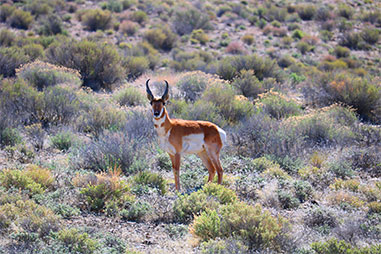 In 2016, Burning Man Project acquired
Fly Ranch,
a strange and wonderful 3,800-acre oasis not far from the
playa, thanks entirely to the generosity of donors who
wanted to help support the next chapter of Burning Man’s
history. We spent the first year and a half as stewards of
this land carefully and curiously exploring every inch of
it, taking stock of its natural features and resources,
and getting to know its plant and animal inhabitants.
In 2016, Burning Man Project acquired
Fly Ranch,
a strange and wonderful 3,800-acre oasis not far from the
playa, thanks entirely to the generosity of donors who
wanted to help support the next chapter of Burning Man’s
history. We spent the first year and a half as stewards of
this land carefully and curiously exploring every inch of
it, taking stock of its natural features and resources,
and getting to know its plant and animal inhabitants.
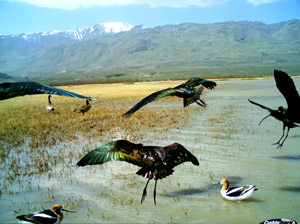 We selected Lisa Schile-Beers (a.k.a. Dr. Scirpus) as our
first Land Fellow. She is exploring and documenting the
flora, fauna, and everything else she comes across on the
Fly Ranch property. Scirpus began volunteering in Black
Rock City in 2006 and now manages the Environmental
Compliance team for the Burning Man event. In the past,
she’s managed the fuel department, worked on the crew
building the Man, worked in the Sign Shop, and maintained
BRC’s eccentric fleet of golf carts. She’s a PhD who
studies wetland ecology throughout the U.S. and
internationally, which made her the ideal candidate to
live on our wet, weird land and document her findings.
We selected Lisa Schile-Beers (a.k.a. Dr. Scirpus) as our
first Land Fellow. She is exploring and documenting the
flora, fauna, and everything else she comes across on the
Fly Ranch property. Scirpus began volunteering in Black
Rock City in 2006 and now manages the Environmental
Compliance team for the Burning Man event. In the past,
she’s managed the fuel department, worked on the crew
building the Man, worked in the Sign Shop, and maintained
BRC’s eccentric fleet of golf carts. She’s a PhD who
studies wetland ecology throughout the U.S. and
internationally, which made her the ideal candidate to
live on our wet, weird land and document her findings.
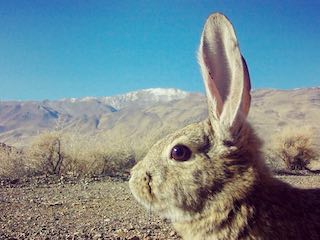 To share her work with the Burning Man community, Scirpus
created a five-part series on the Burning Man Journal
called “Making Sense of Fly Ranch.” Each article dives
deep on the experience of Fly through one of the five
senses. Scirpus complemented her evocative writing with
photos and videos she either shot by hand or captured
remotely with her bevy of “critter cams.” The critter cams
regularly turn out captivating photos of birds, coyotes,
and that beloved Black Rock Desert mascot, the jackrabbit.
We’ve been unable to resist using some of those handsome
bunnies in header images for the flagship Burning Man
newsletter, the Jackrabbit Speaks.
To share her work with the Burning Man community, Scirpus
created a five-part series on the Burning Man Journal
called “Making Sense of Fly Ranch.” Each article dives
deep on the experience of Fly through one of the five
senses. Scirpus complemented her evocative writing with
photos and videos she either shot by hand or captured
remotely with her bevy of “critter cams.” The critter cams
regularly turn out captivating photos of birds, coyotes,
and that beloved Black Rock Desert mascot, the jackrabbit.
We’ve been unable to resist using some of those handsome
bunnies in header images for the flagship Burning Man
newsletter, the Jackrabbit Speaks.
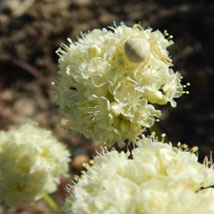 Scripus’s survey of the land and its environment laid the
groundwork for us to begin expanding access to Fly Ranch
in the year to come. In partnership with Friends of Black
Rock/High Rock, a local conservation group, Burning Man
Project is offering weekly low-impact nature walks open to
the public (advance reservation required), so the
community can begin to experience the power and potential
of this land.
Scripus’s survey of the land and its environment laid the
groundwork for us to begin expanding access to Fly Ranch
in the year to come. In partnership with Friends of Black
Rock/High Rock, a local conservation group, Burning Man
Project is offering weekly low-impact nature walks open to
the public (advance reservation required), so the
community can begin to experience the power and potential
of this land.
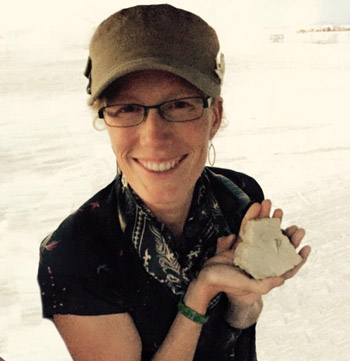 Scirpus is the third Burning Man Project fellow. The
first was Misa Rygrova, Regional Contact for Czech
Republic and Eastern Europe, whose fellowship in 2015
helped highlight and strengthen global Burning Man
communities far from the ancestral home in Nevada. In
2016, Tony “Coyote” Perez-Banuet received a fellowship to
kickstart the writing of his upcoming book,
Coyote Nose: Tales of the Early Desert Carnies of
Burning Man.
Scirpus is the third Burning Man Project fellow. The
first was Misa Rygrova, Regional Contact for Czech
Republic and Eastern Europe, whose fellowship in 2015
helped highlight and strengthen global Burning Man
communities far from the ancestral home in Nevada. In
2016, Tony “Coyote” Perez-Banuet received a fellowship to
kickstart the writing of his upcoming book,
Coyote Nose: Tales of the Early Desert Carnies of
Burning Man.
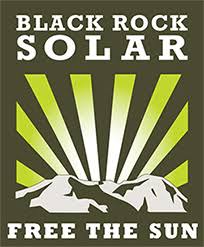 Sometimes projects generated by Burning Man participants
grow up to become thriving, world-changing organizations
in their own right, with domains stretching beyond Burning
Man, though the resonance in values never goes away.
Sometimes these projects end up coming back into the fold
as Burning Man Project programs, as
Burners Without Borders
did. Other times, as with
Black Rock Solar, they take on a life all their own.
Sometimes projects generated by Burning Man participants
grow up to become thriving, world-changing organizations
in their own right, with domains stretching beyond Burning
Man, though the resonance in values never goes away.
Sometimes these projects end up coming back into the fold
as Burning Man Project programs, as
Burners Without Borders
did. Other times, as with
Black Rock Solar, they take on a life all their own.
After almost 10 years transforming northwest Nevada by delivering low-cost solar power solutions, Black Rock Solar decided to “declare victory” in late 2016. In that time they had installed 112 solar arrays, delivering 7,600 kilowatts of clean energy capacity and saving their clients nearly a million dollars a year for the next couple decades. When the market price of solar power dropped (because of widespread adoption of solar), our friends and collaborators decided to pivot and form a new entity: Black Rock Labs.
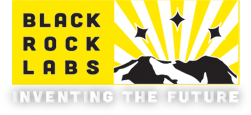 Black Rock Labs’ goal is, quite simply, to spur the
creation of 1,000 new Black Rock Solar-esque entities.
It’s an accelerator for start-up clean-tech products and
services born in the Burning Man community or particularly
well suited for use there. Power generation is one obvious
category, but Burners are also pretty good at low-impact
construction and temporary housing, water and waste stream
management, and more. Looking ahead, Burning Man Project
wants more committed global citizens and ambassadors as
part of our network, and we’re hopeful about the incubator
model Black Rock Labs is pioneering.
Black Rock Labs’ goal is, quite simply, to spur the
creation of 1,000 new Black Rock Solar-esque entities.
It’s an accelerator for start-up clean-tech products and
services born in the Burning Man community or particularly
well suited for use there. Power generation is one obvious
category, but Burners are also pretty good at low-impact
construction and temporary housing, water and waste stream
management, and more. Looking ahead, Burning Man Project
wants more committed global citizens and ambassadors as
part of our network, and we’re hopeful about the incubator
model Black Rock Labs is pioneering.
The first project from Black Rock Labs was helping BRC theme camp IDEATE vet and offer carbon emissions offsets to Burning Man 2017 participants. The offsets came from C-Quest Capital, who use them to install clean-burning cookstoves in rural Zambia to replace the old, carbon-intensive ones. This program saved 877 Burners’ worth of carbon emissions for the 2017 event, and the program will be back and expanded in 2018.
Burning Man Project CEO Marian Goodell was a founding board member of Black Rock Solar and, finding the new mission as compelling and vital as the old one, continues to serve on Black Rock Labs’ board of directors.
 Washington, D.C.’s Burner community really turned up the
heat this year. In November 2016, just days after the
election, the first ever Burning Man Mid-Atlantic
Leadership Conference was held in the nation’s capital,
coinciding with that community’s second annual unofficial
event, Catharsis on the Mall. It was a tough time to be a
community organizer in the U.S., and the D.C. Burners
stepped up to host a gathering of the Burning Man
organizers in their region.
Washington, D.C.’s Burner community really turned up the
heat this year. In November 2016, just days after the
election, the first ever Burning Man Mid-Atlantic
Leadership Conference was held in the nation’s capital,
coinciding with that community’s second annual unofficial
event, Catharsis on the Mall. It was a tough time to be a
community organizer in the U.S., and the D.C. Burners
stepped up to host a gathering of the Burning Man
organizers in their region.
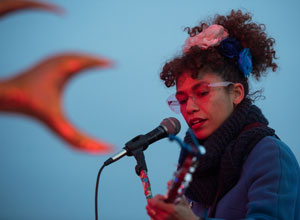 The momentum carried into preparations for the 2017
Catharsis, which drastically stepped up the ambition by
proposing to install 2015 playa star R-Evolution by Marco
Cochrane on the National Mall, a striking symbol of
feminine power. They broke the news of their plans at the
Global Leadership Conference in Oakland, in front of the
largest group of GLC participants ever, showing a dramatic
rendering of the luminous dancer looming over the
Washington Monument. The room was electrified by the
possibility. All systems were go until a sudden,
last-minute reversal by the National Park Service forced
Catharsis to go on without R-Evolution. Despite every
attempt for an appeal, the reversal remained in place.
The momentum carried into preparations for the 2017
Catharsis, which drastically stepped up the ambition by
proposing to install 2015 playa star R-Evolution by Marco
Cochrane on the National Mall, a striking symbol of
feminine power. They broke the news of their plans at the
Global Leadership Conference in Oakland, in front of the
largest group of GLC participants ever, showing a dramatic
rendering of the luminous dancer looming over the
Washington Monument. The room was electrified by the
possibility. All systems were go until a sudden,
last-minute reversal by the National Park Service forced
Catharsis to go on without R-Evolution. Despite every
attempt for an appeal, the reversal remained in place.
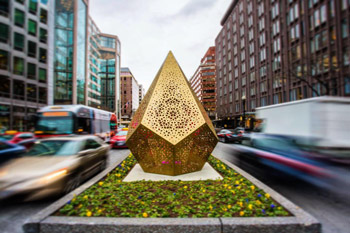 Undaunted, D.C. Burners looked ahead to the upcoming “No
Spectators: The Art of Burning Man” exhibition at the
Smithsonian American Art Museum’s Renwick Gallery, which
would open in March 2018. The local Burners convinced
their neighbors at the Renwick and the surrounding Golden
Triangle Business Improvement District to expand the
concept of the exhibition beyond the walls of the museum.
While their original vision was thwarted, their
persistence paved the way for new art engagement. The
museum exhibition would be accompanied by public art
installations throughout D.C., and Burners — and
non-Burners! — riding around on bikes experiencing it all
with Immediacy.
Undaunted, D.C. Burners looked ahead to the upcoming “No
Spectators: The Art of Burning Man” exhibition at the
Smithsonian American Art Museum’s Renwick Gallery, which
would open in March 2018. The local Burners convinced
their neighbors at the Renwick and the surrounding Golden
Triangle Business Improvement District to expand the
concept of the exhibition beyond the walls of the museum.
While their original vision was thwarted, their
persistence paved the way for new art engagement. The
museum exhibition would be accompanied by public art
installations throughout D.C., and Burners — and
non-Burners! — riding around on bikes experiencing it all
with Immediacy.
 The 2017 art theme, “Radical Ritual,” was a slow-burner.
At first, it seemed almost obvious; yes, Black Rock City
is a ritual we repeat every year; yes, we will always Burn
the Man; yes, humans have been doing this kind of thing
forever. What’s so radical about that? But, as we
built up toward the event, and as ever-ready theme
philosopher Caveat Magister unfurled more and more aspects
to
Radical Ritual in the Burning Man Journal, it became clear how radical an idea it was to look at
Burning Man’s rituals as rituals, and not That mere
Thing in the Desert (and now far beyond it).
The 2017 art theme, “Radical Ritual,” was a slow-burner.
At first, it seemed almost obvious; yes, Black Rock City
is a ritual we repeat every year; yes, we will always Burn
the Man; yes, humans have been doing this kind of thing
forever. What’s so radical about that? But, as we
built up toward the event, and as ever-ready theme
philosopher Caveat Magister unfurled more and more aspects
to
Radical Ritual in the Burning Man Journal, it became clear how radical an idea it was to look at
Burning Man’s rituals as rituals, and not That mere
Thing in the Desert (and now far beyond it).
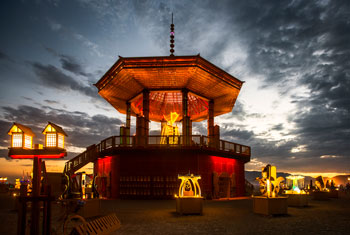 In 2016, the Man build was ambitious and complex, which
caused some problems. Radical Ritual brought us back
around to the Man’s simple essence. The Man Base was
dedicated to the Golden Spike, the ritual at the end of
Survey that marks the center point of what will become
Black Rock City. For the first time since 2000, the Man
was standing on the ground and was hoisted by human power.
In 2016, the Man build was ambitious and complex, which
caused some problems. Radical Ritual brought us back
around to the Man’s simple essence. The Man Base was
dedicated to the Golden Spike, the ritual at the end of
Survey that marks the center point of what will become
Black Rock City. For the first time since 2000, the Man
was standing on the ground and was hoisted by human power.
 But the build featured some novel ideas, too. Burning Man
founder and theme creator Larry Harvey, always the
maverick, audaciously proposed putting the Man
inside a temple, an unprecedented step met with
skepticism from some purists — much to Larry’s delight.
Radical Ritual invited us to celebrate the things we’ve
learned how to do as a culture, and to fuse the old ways
with the new; even though the Man was raised by the
classic, low-tech method, the roof over its head was the
heaviest crane-lifted object lifted by DPW in the event’s
history.
But the build featured some novel ideas, too. Burning Man
founder and theme creator Larry Harvey, always the
maverick, audaciously proposed putting the Man
inside a temple, an unprecedented step met with
skepticism from some purists — much to Larry’s delight.
Radical Ritual invited us to celebrate the things we’ve
learned how to do as a culture, and to fuse the old ways
with the new; even though the Man was raised by the
classic, low-tech method, the roof over its head was the
heaviest crane-lifted object lifted by DPW in the event’s
history.
Of course, building (and unbuilding) Black Rock City is a ritual of many rituals, from taking cereal bags out of their boxes and putting socks in zip-lock bags while you pack, all the way through the event and its art burns, to the last little tab from an aluminum can getting dropped in the last MOOP bag on the last day of Playa Restoration. It may be one of Burning Man’s greatest lessons that these activities, however quotidian, are not mundane — they are essential pieces comprising a glorious whole.
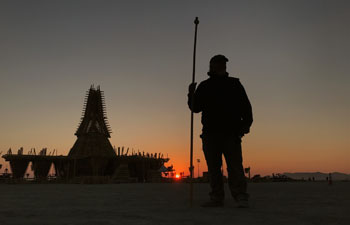 This stuff is hard to transmit. It is essential to what
Burning Man is that you have to experience it to
understand it. But that essence is the wisdom of
Burning Man, and clearly Burning Man does transmit it
through experiential learning. Burning Man Project is
investing in an Education and Learning Initiative to build
tools for connection, communication, and distribution, so
that we can find the ways to share this wisdom, both on
specific, local scales as well as in a global language.
This stuff is hard to transmit. It is essential to what
Burning Man is that you have to experience it to
understand it. But that essence is the wisdom of
Burning Man, and clearly Burning Man does transmit it
through experiential learning. Burning Man Project is
investing in an Education and Learning Initiative to build
tools for connection, communication, and distribution, so
that we can find the ways to share this wisdom, both on
specific, local scales as well as in a global language.


